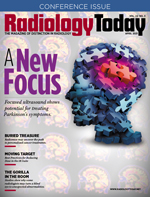 Radiography News: X-Ray Vision — New Algorithm Can Assist COVID-19 Screening
Radiography News: X-Ray Vision — New Algorithm Can Assist COVID-19 Screening
By Keith Loria
Radiology Today
Vol. 22 No. 3 P. 8
A recent study published in the peer-reviewed journal PLOS ONE shows 95.6% sensitivity and 88.7% specificity for COVID-19 pneumonia on actual positive chest radiographs analyzed by an algorithm, rates that are higher than formal radiology reports. The algorithm, Lunit’s INSIGHT CXR, demonstrated a satisfactory diagnostic performance (AUROC=0.921) in diagnosing pneumonia from the images of COVID-19 patients.
“The purpose of this study was to examine the performance of an AI algorithm that detects COVID-19 pneumonia from chest X-ray images, compared with that of radiology reports,” says Ki-hwan Kim, chief medical officer of Lunit, a South Korean medical AI company. “This study also validated the diagnostic performance and efficacy of AI in analyzing the X-ray images of COVID-19 patients based on a multicenter study.”
Kim explains that during outbreaks of rapidly transmitted infectious diseases, such as current COVID-19, early isolation and detection of suspected patients is the most basic and important response strategy in emergency departments (EDs).
“Chest radiography constitutes a fast and relatively inexpensive imaging modality for finding lesions in the lungs, especially for COVID-19–related findings, such as consolidation and ground-glass opacity (GGO),” Kim says. “The portability of CR equipment can protect medical personnel from viruses and minimize the risk of spreading the virus.”
However, because chest X-rays compress and represent 3D human lungs as a 2D image, there may be lesions that are easily missed by physicians or radiologists, especially GGO, which exhibits unclear boundaries, often resulting in images that lack clarity. This makes detection in chest X-rays difficult for nonexpert clinicians, especially in EDs.
“In this regard, the study was to evaluate the efficacy of Lunit INSIGHT CXR for detecting COVID-19 pneumonia on chest radiography, thus assessing its value in triaging COVID-19 patients,” Kim says.
Positive Findings
The median time of ED admissions upon diagnosis of COVID-19 through reverse transcription polymerase chain reaction (RT-PCR) testing was approximately seven hours, which in Korea in February 2020 had caused a temporary closure of EDs. Given that the timely diagnosis by RT-PCR can be limiting in a pandemic situation and radiological abnormality may precede the conclusive RT-PCR positive outcome, Kim notes that CR imaging can help the early diagnosis or triage of patients in pandemic situations. The sensitivity and specificity of the algorithm showed that it may be acceptable for use in clinical practice in COVID-19 pandemic situations. The algorithm’s diagnostic performance implies that it can detect lung abnormalities and lesions at a highly accurate level.
“It takes only around 10 seconds to get the analysis result, meaning it can even provide benefits to medical staff who are under harsh clinical conditions or medical assistants, ie, radiographers,” Kim says. “In particular conditions such as COVID-19 where a timely treatment is mandatory but there is a lack of medical professionals, radiographers can check the AI result in advance and take necessary care temporarily, eg, triage or isolate emergency patients for appropriate treatment.”
Previous research has demonstrated the clinical efficacy of the AI algorithm in terms of its ability to improve speed and accuracy in image reading. By achieving a performance that is equivalent to physicians in the detection of abnormal chest radiography findings within COVID-19 settings, automatic interpretation with AI has the potential to significantly reduce the burden on clinicians and radiologists during a sudden surge of suspected COVID-19 patients.
“In pandemic situations such as COVID-19, wherein medical resources and personnel are limited, the emergency medical system can be burdened considerably,” Kim says. “In this context, the algorithm offers fast and reliable examinations that can facilitate decisions regarding patient screening and isolation, triaging the patients who need emergent or advanced diagnosis. This can reduce the workload on medical staff.”
AI in Action
Medical professionals in more than 10 countries, including major health care institutions in South Korea, Thailand, Indonesia, Brazil, Mexico, Italy, and France, are currently using the algorithm to diagnose COVID-19. It has been installed at PreventSenior, one of the largest hospital networks in Brazil, with eight locations throughout the metropolitan region of Sao Paulo. This institution is one of the COVID-19 detection centers that use chest X-ray screening for patients with mild symptoms.
“Medical workers here are telling us that it is providing great help, especially for patient triage, as the hospital is overflowing with patients while the number of radiologists remains low,” Kim says.
Aside from COVID-19 usage, the algorithm has an accuracy of 97% to 99% in detecting 10 major chest diseases, such as lung nodules and pneumothorax. It is CE marked and clinically available in Europe, the Middle East, Latin America, South East Asia, Australia, and New Zealand. FDA approval is expected this year.
“With the data gathered from the global sites where our AI software is used, we plan to conduct a retrospective study using the data, to further evaluate the value and effectiveness of AI during a pandemic situation,” Kim says. “COVID-19 will eventually regress, but there always are possibilities for another outbreak of unknown diseases. Regardless of the disease, our hopes are that AI can provide assistance to the health care professionals working in the frontline of the pandemic.”
Various types of respiratory infectious diseases occur periodically, he notes, and imaging-based diagnosis will play an important role before a new diagnostic kit is developed; chest X-rays and AI can provide significant value.
“We will continue to find and build evidence, as well as improve our solutions, to help manage a future pandemic to come,” Kim says.
— Keith Loria is a freelance writer based in Oakton, Virginia. He is a frequent contributor to Radiology Today.

